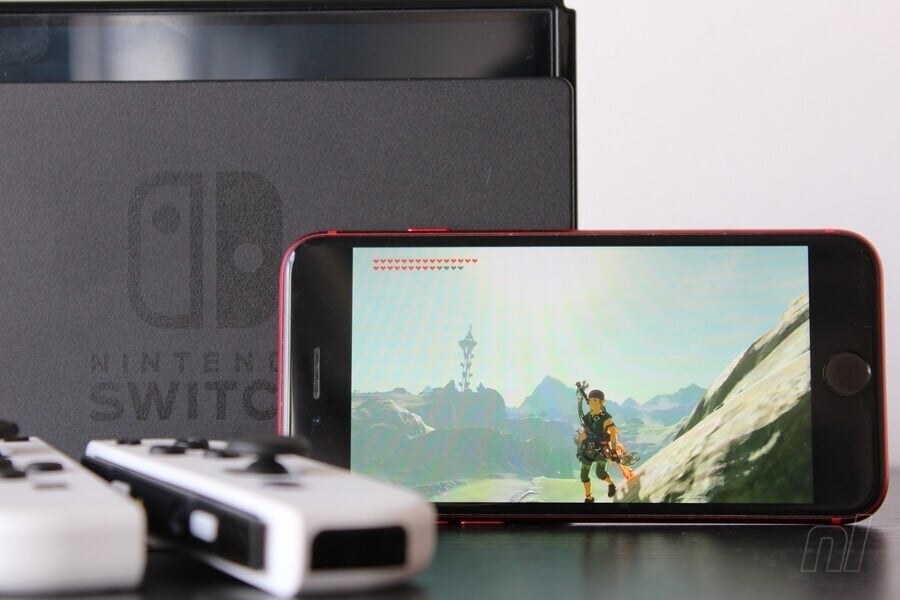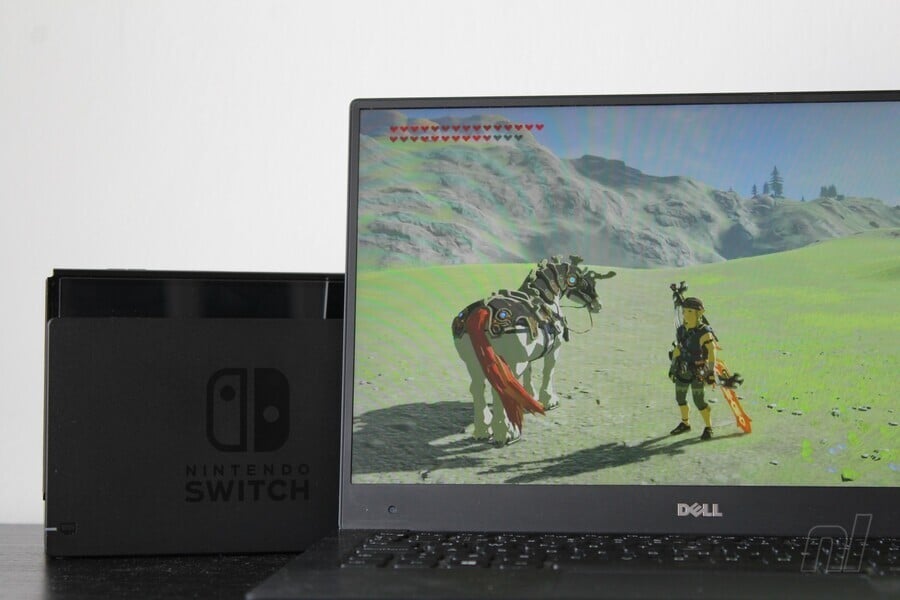Products You May Like

The namesake feature of Nintendo’s hybrid console has been perhaps the key factor in its continued success. The Switch’s ability to, well, switch means it fits neatly into any lifestyle whatever your situation, but that doesn’t mean there aren’t use cases it doesn’t quite cater for. For our part — and especially in the pre-Switch OLED days — we’ve often wished we could use our laptop screen or even play via a tablet to get a boost in screen size over the Switch’s screen in tabletop mode. We’re surrounded by large screens in the office, but we can’t play on as many of them as we’d like.
That’s where the AURGA Viewer comes in. Described as a 5-in-1 wireless HDMI streaming transmitter, when coupled with the requisite app it turns your phone, tablet, or laptop screen into a wireless display for whatever content you wish to throw on it via Bluetooth 4.1. Transmitting a 1080p/60Hz signal, you can use it to turn your iPad into a second monitor, for example, but for our purposes, it’s the ability to output your docked Switch to those screens which is the attraction. Devices such as the Genki Shadowcast offer similar functionality for Switch gamers, but with Aurga quickly blowing through its initial Kickstarter goal, we were keen to see how this option faired.
Aurga — the Hong Kong-based firm behind the device — cites various use cases for its eponymous Viewer that Switch owners might find attractive, but playing on a phone simply isn’t worth the effort given the Switch’s perfectly useable 720p screen, not to mention the Switch OLED’s beautiful panel.
Aurga kindly sent us an early sample unit with a non-final power convertor for testing. As you can see from the photos on this page, the dongle itself is powered via an adaptor which sits in between the Switch’s power slot and supply. We weren’t able to close the rear flap on our Switch dock with this setup installed, although a planned redesign will switch USB-A for USB-C. Likewise, the current setup isn’t physically compatible with the Switch OLED dock (at least not comfortably so).
Once installed and powered, the dongle becomes a wireless hotspot and you simply connect your device before firing up Aurga’s iOS or Android app (we’ll come to Windows in a moment). You can connect via a router if you prefer, although the hotspot option will give the best results in terms of latency. The interface of the app itself is clean and intuitive, with various gestures to navigate the menu when you’re in fullscreen mode.
Once everything was hooked up and running, we fired up Sonic Origins for a blast through Sonic 1. As with any streaming solution, most gamers savvy enough to be interested in the tech will have one question: What’s the lag like? We weren’t able to take exact measurements but the results with the sample unit we tested were…mixed.
initial results were perfectly playable, with gameplay and audio in sync and a relatively smooth and steady frame rate…However, an issue flared up within a couple of minutes
While we could tell things weren’t quite as snappy on iPad as we ran through Green Hill Zone, initial results were perfectly playable, with gameplay and audio in sync and a relatively smooth and steady frame rate. Image-wise, it looked absolutely excellent on the tablet; crisp and bright with no visible artefacts or blurring.
However, an issue flared up within a couple of minutes. The frame rate got progressively worse and a buzzing audio bug — which sounded like electronic ‘static’ — steadily grew until the app crashed. Opening the app immediately, things would look fine until the same one or two-minute cycle began again. This affected tests both on mobile (a second-generation iPhone SE running iOS 16) and tablet (a fourth-gen iPad Pro running iOS 14.6). After speaking with the developer, they acknowledged iOS issues and said an update was due very soon. We weren’t able to test Android, unfortunately.
Not the best of first impressions, then! We persevered with our iPad, resetting and reconnecting everything several times. We moved on to Mario Kart 8 Deluxe next, which ranged from passable at best to totally unplayable due to the same issue. You are able to connect multiple devices to the Aurga’s hotspot (which we did to capture a couple of images), but it isn’t recommended for actual gameplay unless your WiFi environment is stellar — ours is simply robust.
After troubleshooting, we gave up and opened our laptop. Although not publicly available at the time of writing, we were able to test an early version of the Windows app. Happily, after some teething troubles, we were pleased to see things begin to function as advertised.
Given the convenience of Switch in its vanilla form, any device that adds to its functionality has to be similarly plug-and-play if it wants to succeed
Connecting once again to the Aurga’s hotspot, we returned to Green Hill Zone and, this time, the game was perfectly playable with only the occasional hiccup. We were very much aware of some latency, but that’s part and parcel of using streaming tech for gaming. We returned to Mario Kart 8 and, lo and behold, our Waluigi zoomed to first place with a very smooth and solid performance. Not perfect — that slight hitch here and there still has the power to irk — but perfectly playable, with the streamed video crucially being no impediment to our enjoyment of the game.
Not wanting to go easy on the device with slower-paced games, we threw something faster at it. Cuphead — which we expected the Aurga to struggle with — worked surprisingly well. The Aurga Viewer was functioning and had turned our laptop into a Switch screen outputting the full 1080p of the dock very respectably. Praise be!
We slowed things down with Breath of the Wild, which was similarly impressive, barring a couple of instances of the image slowing down and then speeding up. The desktop version coped admirably during our tests, feeling smooth and responsive for the most part. We also spent several hours playing Star Trek Prodigy: Supernova for review with the device and had little or no trouble.
At least during that session. The following day, we ran into problems getting the PC program to run, and when it did we saw frame rate jitters which rendered the game pretty much unplayable. Evidently, the Windows app is in a beta state, so issues like this are hardly unexpected, but coupled with our iOS experience, it left a sour taste in our mouth. If we persevered, we’re pretty sure we could replicate the perfect conditions once again and get to that good experience, but this brings us to the crux of the matter.
Given the convenience of Switch in its vanilla form, any device that adds to its functionality has to be similarly plug-and-play if it wants to succeed. Having players abandoning it with a frustrated, “oh nuts to it, I’ll just play in handheld” would be all too easy. Given our time with this early sample, we’d say that Aurga is fortunate that the applications for this device go beyond gaming. In between disappointments, we glimpsed the Aurga Viewer’s potential and got a good few hours of solid performance from it. The iOS mobile and tablet versions were non-starters and will need addressing before launch, however. Given the right conditions, there is potential here.
So then, ‘patchy’ is how we’d describe our time with the Aurga Viewer. Assuming the considerable iOS wrinkles we experienced can be ironed out, we saw enough glimpses of redemption courtesy of the Windows app to still be interested, although our patience wore thin. The effectiveness of this device — and your satisfaction — will ultimately depend on the types of games you play and your personal tolerance for latency, even if we generously assume the issues we experienced can be solved. As with any streaming solution, locally or via the cloud, you’ll want to avoid twitch-reflex titles or anything being played online. A minor delay is perfectly acceptable in many games, though — not optimal, but acceptable.
The real question, then, is if Aurga can set things right before launch when it comes to iOS and make the Aurga Viewer plug-and-play enough to appeal to Switch owners accustomed to the most convenient console there is. While it might be perfectly useable in other fields, the jury’s still out on its gaming usefulness.

AURGA’s Kickstarter still has a couple of weeks to run at the time of writing. Thanks to them for providing the sample for this feature.
